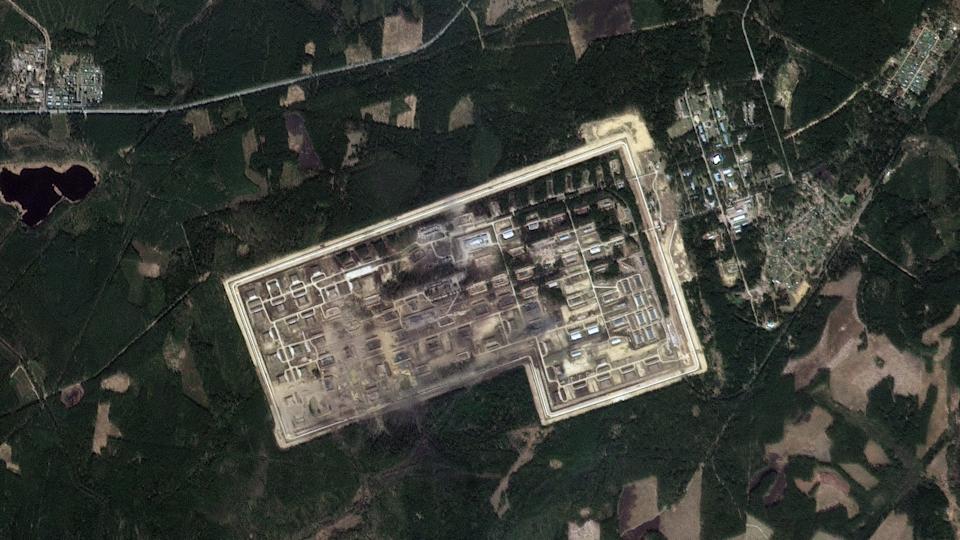Overview of the Incident
The UK Defense Ministry has reported that poor weapons handling and inadequate storage procedures likely led to a catastrophic explosion at Russia’s 51st GRAU arsenal. This incident, which occurred in late April, raised significant concerns about the safety practices surrounding military munitions in Russia.
Significant Damage and Historical Context
The 51st GRAU depot, recognized as one of the largest ammunition storage facilities in Russia, experienced extensive damage due to multiple explosions following a fire that ignited on April 22. The UK Defense Ministry characterized the incident as one of the most substantial losses of munitions through the actions of Russian troops since the onset of the full-scale war in Ukraine.
In its intelligence update, the ministry conveyed that the blasts were likely a result of “poor weapons handling procedures” coupled with “negligent storage of munitions.” Such incidents are not new; the ministry highlighted a troubling pattern of Russian ineptitude concerning munitions safety, which has been evident for years.
The Explosion and Its Aftermath
Following the fire, the depot experienced a series of massive explosions that echoed across the region, causing alarm and drawing attention to the safety protocols in place at such facilities. While the Russian government did not officially identify the facility involved, they acknowledged that a fire resulted in munitions detonating, attributing the explosion to “violations of safety requirements when working with explosive materials.”
Satellite imagery, obtained by media outlets, revealed that the damage inflicted on the depot was severe, affecting large sections of the facility. The UK Defense Ministry estimated that more than one square kilometer of the depot sustained damage from the explosions, indicating considerable losses from a critical strategic location in Russia’s armory.
The Scale of Munitions Stored
According to Ukrainian intelligence, the 51st GRAU depot was reported to house around 105,000 tons of munitions, which included various types of weapons such as ballistic missiles, air-launched munitions, and air defense systems. Purposefully categorized as one of Russia’s largest munitions repositories, its loss represents a significant blow to the Kremlin’s military capabilities.
Furthermore, officials from Ukraine indicated that artillery shells were also stored in this depot, underscoring the arsenal’s critical role in supporting combat operations. In addition to the initial damage caused by the explosions, footage circulating on social media suggested that the civilian areas surrounding the depot experienced secondary explosions, heightening concerns about the impact on local communities.
Previous Incidents and Ongoing Threats
This incident at the 51st GRAU depot is not an isolated case. Historical records indicate that the same facility has faced explosive incidents in the past. For instance, reports from Russian state media in June 2022 described a tragic event in which four individuals lost their lives due to a “spontaneous detonation” of a shell while ammunition was being loaded and unloaded at the depot.
These repeated incidents prompt questions about the effectiveness of safety measures in place and raise alarms about the risks posed to both military personnel and civilians living near such facilities. The pattern of mishandling munitions could not only threaten immediate safety but also compromise operational effectiveness in military campaigns.
Broader Implications for Russian Military Operations
The recent explosion reflects broader operational challenges faced by the Russian military, particularly as it continues its military engagement in Ukraine. The loss of such a significant quantity of munitions undermines Russia’s ability to sustain its military operations over the long term. Additionally, the apparent negligence regarding munitions safety could indicate deeper systemic issues within the military’s logistical and operational frameworks.
The UK Defense Ministry’s findings emphasize that the Russian military’s track record on munitions handling and safety is fraught with examples of mismanagement, potentially jeopardizing future military endeavors. The Kremlin is likely to be scrutinized further, both internally and externally, regarding its operational effectiveness and adherence to safety protocols.
Conclusion
The explosion at the 51st GRAU arsenal serves as a reminder of the critical importance of stringent safety measures in military settings. As military conflicts evolve, ensuring the safe handling and storage of munitions is paramount to preventing incidents that not only threaten military personnel but also endanger the populations living in proximity to these facilities. The implications of this incident extend beyond local damages; they resonate throughout the Russian military’s operational capabilities and raise pressing questions about its preparedness moving forward.
https://www.yahoo.com/news/russias-poor-weapons-handling-likely-050737048.html



